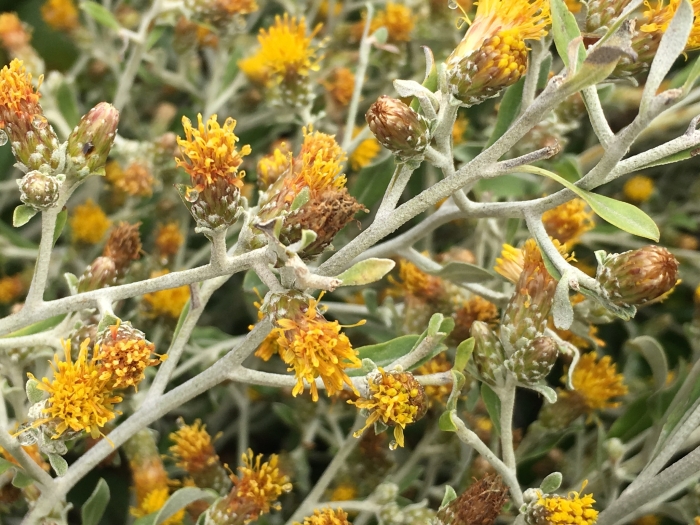Guadalupe Hazardia
(Hazardia cana)
Guadalupe Hazardia (Hazardia cana)
/
/

Adam J. Searcy
CC BY 4.0
Image By:
Adam J. Searcy
Recorded By:
Copyright:
CC BY 4.0
Copyright Notice:
Photo by: Adam J. Searcy | License Type: CC BY 4.0 | License URL: http://creativecommons.org/licenses/by/4.0/ | Rights Holder: Adam J. Searcy | Publisher: iNaturalist | Date Created: 2019-06-21T10:30:15-07:00 |
























Estimated Native Range
Summary
Hazardia cana, commonly known as Guadalupe hazardia or San Clemente Island hazardia, is a perennial shrub native to coastal sage scrub and chaparral habitats on San Clemente Island in California and Guadalupe Island in Baja California. It typically grows up to 6.5 feet high and is characterized by its bushy form, woolly and glandular leaves, and cylindrical flower heads. The shrub produces yellow florets that may age to red or purple, blooming from late summer to fall. The flowers are moderately showy and attract pollinators.
Guadalupe hazardia is valued for its drought tolerance and ability to thrive in poor, rocky soils, making it suitable for xeriscaping and habitat restoration projects. It is also used for ornamental purposes in native plant gardens and as part of natural landscaping designs. In cultivation, it requires little maintenance once established, preferring full sun to partial shade and well-drained soils. While it is not commonly affected by diseases, it is important to avoid overwatering to prevent root rot. This species is recovering from overgrazing by feral goats, which have now been removed from its habitat, allowing natural regeneration to occur.CC BY-SA 4.0
Guadalupe hazardia is valued for its drought tolerance and ability to thrive in poor, rocky soils, making it suitable for xeriscaping and habitat restoration projects. It is also used for ornamental purposes in native plant gardens and as part of natural landscaping designs. In cultivation, it requires little maintenance once established, preferring full sun to partial shade and well-drained soils. While it is not commonly affected by diseases, it is important to avoid overwatering to prevent root rot. This species is recovering from overgrazing by feral goats, which have now been removed from its habitat, allowing natural regeneration to occur.CC BY-SA 4.0
Plant Description
- Plant Type: Shrub
- Height: 2-3 feet
- Width: 2-3 feet
- Growth Rate: Moderate
- Flower Color: Yellow
- Flowering Season: Summer, Fall
- Leaf Retention: Evergreen
Growth Requirements
- Sun: Full Sun, Part Shade
- Water: Low
- Drainage: Medium, Fast
Common Uses
Butterfly Garden, Deer Resistant, Drought Tolerant, Low Maintenance
Natural Habitat
Native to coastal sage scrub and chaparral habitats on San Clemente Island and Guadalupe Island
Other Names
Common Names: Hoary Brickellbush, San Clemente Island Bristleweed, Island Hazardia, Hoary Hazardia
Scientific Names: , Hazardia cana, Corethrogyne cana, Diplostephium canum, Haplopappus canus,
GBIF Accepted Name: